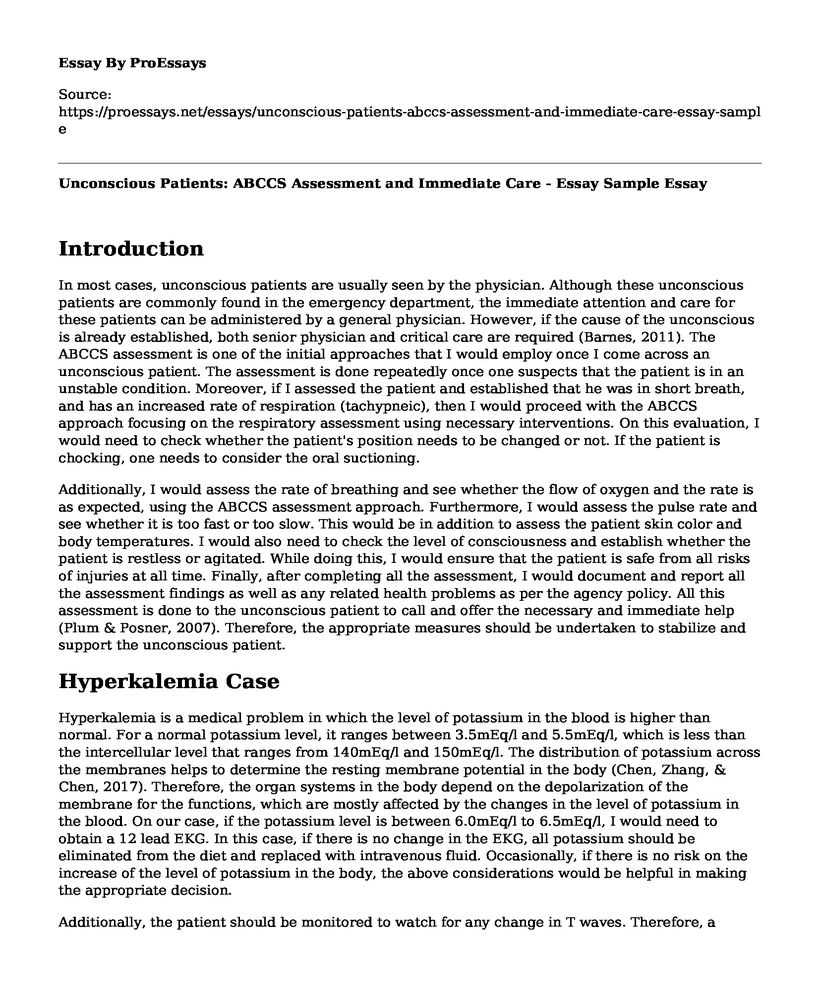Introduction
In most cases, unconscious patients are usually seen by the physician. Although these unconscious patients are commonly found in the emergency department, the immediate attention and care for these patients can be administered by a general physician. However, if the cause of the unconscious is already established, both senior physician and critical care are required (Barnes, 2011). The ABCCS assessment is one of the initial approaches that I would employ once I come across an unconscious patient. The assessment is done repeatedly once one suspects that the patient is in an unstable condition. Moreover, if I assessed the patient and established that he was in short breath, and has an increased rate of respiration (tachypneic), then I would proceed with the ABCCS approach focusing on the respiratory assessment using necessary interventions. On this evaluation, I would need to check whether the patient's position needs to be changed or not. If the patient is chocking, one needs to consider the oral suctioning.
Additionally, I would assess the rate of breathing and see whether the flow of oxygen and the rate is as expected, using the ABCCS assessment approach. Furthermore, I would assess the pulse rate and see whether it is too fast or too slow. This would be in addition to assess the patient skin color and body temperatures. I would also need to check the level of consciousness and establish whether the patient is restless or agitated. While doing this, I would ensure that the patient is safe from all risks of injuries at all time. Finally, after completing all the assessment, I would document and report all the assessment findings as well as any related health problems as per the agency policy. All this assessment is done to the unconscious patient to call and offer the necessary and immediate help (Plum & Posner, 2007). Therefore, the appropriate measures should be undertaken to stabilize and support the unconscious patient.
Hyperkalemia Case
Hyperkalemia is a medical problem in which the level of potassium in the blood is higher than normal. For a normal potassium level, it ranges between 3.5mEq/l and 5.5mEq/l, which is less than the intercellular level that ranges from 140mEq/l and 150mEq/l. The distribution of potassium across the membranes helps to determine the resting membrane potential in the body (Chen, Zhang, & Chen, 2017). Therefore, the organ systems in the body depend on the depolarization of the membrane for the functions, which are mostly affected by the changes in the level of potassium in the blood. On our case, if the potassium level is between 6.0mEq/l to 6.5mEq/l, I would need to obtain a 12 lead EKG. In this case, if there is no change in the EKG, all potassium should be eliminated from the diet and replaced with intravenous fluid. Occasionally, if there is no risk on the increase of the level of potassium in the body, the above considerations would be helpful in making the appropriate decision.
Additionally, the patient should be monitored to watch for any change in T waves. Therefore, a repeated measure for the potassium level should be done at least every twelve to twenty-four hours to ensure for the resolution of hyperkalemia. Moreover, if there is no risk factor for the level of potassium increasing the renal failure, measures should be taken to eliminate the potassium in the blood (Lewis, 2010). This should be done by administering sodium polystyrene which contains a 1g/kg per dose at every six hours PO, or at every two to four hours PR. Hence, I would recheck the level of the potassium to find out whether there are any changes of EKG in the cardiorespiratory monitoring. The most important adverse effect on the control of the hyperkalemia is overtreatment. To avoid this, I would consider the urgency of hyperkalemia treatment as well as the overresponse risk factors for an intravenous replacement.
References
Barnes, L. (2011). Emergency care and transportation of the sick and injured. Sudbury, Mass. [u.a.:Jones and Bartlett.
Chen, Q., Zhang, W.-G., & Chen, S.-C. (2017). Clinical analysis of hyperkalemia after esophagectomy. Baltimore, Md: Lippincott, Williams & Wilkins.
Lewis, K. M. (2010). Multiple lead ECGs: a practical analysis of arrhythmias. New York: Delmar Cengage Learning.
Plum, F., & Posner, J. B. (2007). Plum and Posner's diagnosis of stupor and coma. Oxford [etc.: Oxford University Press.
Cite this page
Unconscious Patients: ABCCS Assessment and Immediate Care - Essay Sample. (2023, Feb 15). Retrieved from https://proessays.net/essays/unconscious-patients-abccs-assessment-and-immediate-care-essay-sample
If you are the original author of this essay and no longer wish to have it published on the ProEssays website, please click below to request its removal:
- Vaccine Controversy Effect on Nurses Essay
- Essay Example on Work-Life Balance: A Stressful Reality for Working Mothers
- Paper Example on IAD: Causes, Signs, and Prevention of Incontinence-Associated Dermatitis
- Essay Sample on Noise-Induced Hearing Loss: How Loud Environments Damage Our Hearing
- Nurses' Perceptions of Patient Safety in Community Mental Health - Essay Sample
- Paper Example on Prescribing Opioids in US: Dentists Lead the Way
- Essay Example on Vaccination: Key to Disease Prevention & Survival







